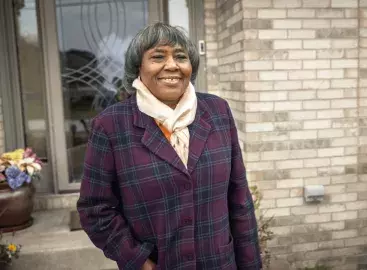Shirley Poe - What Every Chronic Pain Sufferer Needs to Know (Dr. Lubenow)
 According to a new survey of people with chronic pain, 68 percent in Illinois aren’t satisfied with their current treatment. Local Shirley Poe can relate.
According to a new survey of people with chronic pain, 68 percent in Illinois aren’t satisfied with their current treatment. Local Shirley Poe can relate.
Ten years ago, she was diagnosed with lumbar spinal stenosis (compressed spinal cord). Poe tried multiple medications, which didn’t provide pain relief.
The pain was so debilitating that she couldn’t walk more than a few steps at a time, making even a trip to the store challenging.
According to the CDC, 50+ million people nationwide are struggling with chronic pain that lasts six months or longer without finding relief. One of the most common reasons that adults seek medical care, chronic pain has been linked to restrictions in mobility, dependence on opioids, anxiety and depression, and reduced quality of life.1 Unfortunately, less than half of those surveyed in Illinois are aware of drug-free, minimally-invasive, interventional therapies helping patients such as Poe return to activities they love and regain hope for their future.
Poe sought help from a pain management specialist – a doctor trained to address chronic pain. That’s when she learned about interspinous spacers, which relieve back pain by restoring the normal space between the vertebrae.
Initially, Poe didn’t know much about this treatment, but after undergoing the Boston Scientific Vertiflex™ Procedure, she champions it.
“Before Vertiflex, my pain forced me to give up my active lifestyle. Now there are very few limitations on what I can do,” says Poe.
Shirley P., Vertiflex Procedure patient since 2018 Provided “The experience of chronic pain is complex and unique to every person. But pain management specialists have many tools in our arsenal that can provide adequate, lasting, personalized pain relief,” says Dr. Timothy Lubenow, Professor of Anesthesiology and Program Director for Pain Medicine Fellowship at Rush University Medical Center Pain Clinic.
The new survey found that 96 percent of chronic pain sufferers in Illinois would try an FDA-approved, drug-free alternative to help manage chronic pain.
Dr. Lubenow notes that for patients with moderate lumbar spinal stenosis, interspinous spacers may relieve pain in the lower back, legs, groin and buttocks. For those with chronic pain in the lower back, legs and feet, spinal cord stimulation offers a personalized experience that can treat multiple pain areas simultaneously by interrupting pain signals from reaching the brain. Alternatively, radiofrequency ablation delivers a small current to interrupt pain signals at the source. Individual results may vary.
To find a pain management specialist and learn more about chronic pain, visit: www.rushpaincenter.com
